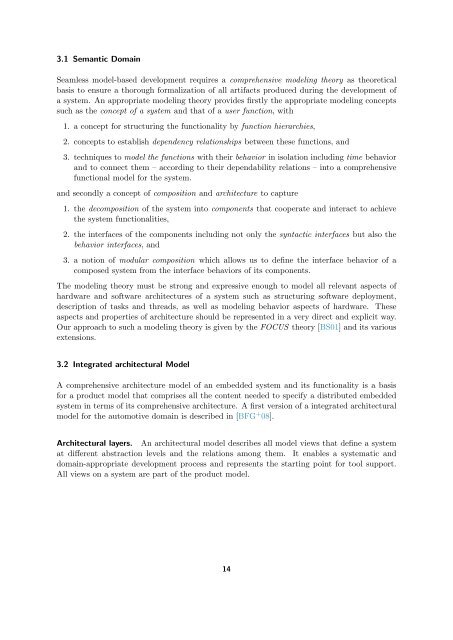SPES 2020 Deliverable 1.4.B-3 Concepts for an Integrated Tool ...
SPES 2020 Deliverable 1.4.B-3 Concepts for an Integrated Tool ...
SPES 2020 Deliverable 1.4.B-3 Concepts for an Integrated Tool ...
You also want an ePaper? Increase the reach of your titles
YUMPU automatically turns print PDFs into web optimized ePapers that Google loves.
3.1 Sem<strong>an</strong>tic Domain<br />
Seamless model-based development requires a comprehensive modeling theory as theoretical<br />
basis to ensure a thorough <strong>for</strong>malization of all artifacts produced during the development of<br />
a system. An appropriate modeling theory provides firstly the appropriate modeling concepts<br />
such as the concept of a system <strong>an</strong>d that of a user function, with<br />
1. a concept <strong>for</strong> structuring the functionality by function hierarchies,<br />
2. concepts to establish dependency relationships between these functions, <strong>an</strong>d<br />
3. techniques to model the functions with their behavior in isolation including time behavior<br />
<strong>an</strong>d to connect them – according to their dependability relations – into a comprehensive<br />
functional model <strong>for</strong> the system.<br />
<strong>an</strong>d secondly a concept of composition <strong>an</strong>d architecture to capture<br />
1. the decomposition of the system into components that cooperate <strong>an</strong>d interact to achieve<br />
the system functionalities,<br />
2. the interfaces of the components including not only the syntactic interfaces but also the<br />
behavior interfaces, <strong>an</strong>d<br />
3. a notion of modular composition which allows us to define the interface behavior of a<br />
composed system from the interface behaviors of its components.<br />
The modeling theory must be strong <strong>an</strong>d expressive enough to model all relev<strong>an</strong>t aspects of<br />
hardware <strong>an</strong>d software architectures of a system such as structuring software deployment,<br />
description of tasks <strong>an</strong>d threads, as well as modeling behavior aspects of hardware. These<br />
aspects <strong>an</strong>d properties of architecture should be represented in a very direct <strong>an</strong>d explicit way.<br />
Our approach to such a modeling theory is given by the FOCUS theory [BS01] <strong>an</strong>d its various<br />
extensions.<br />
3.2 <strong>Integrated</strong> architectural Model<br />
A comprehensive architecture model of <strong>an</strong> embedded system <strong>an</strong>d its functionality is a basis<br />
<strong>for</strong> a product model that comprises all the content needed to specify a distributed embedded<br />
system in terms of its comprehensive architecture. A first version of a integrated architectural<br />
model <strong>for</strong> the automotive domain is described in [BFG + 08].<br />
Architectural layers. An architectural model describes all model views that define a system<br />
at different abstraction levels <strong>an</strong>d the relations among them. It enables a systematic <strong>an</strong>d<br />
domain-appropriate development process <strong>an</strong>d represents the starting point <strong>for</strong> tool support.<br />
All views on a system are part of the product model.<br />
14
















